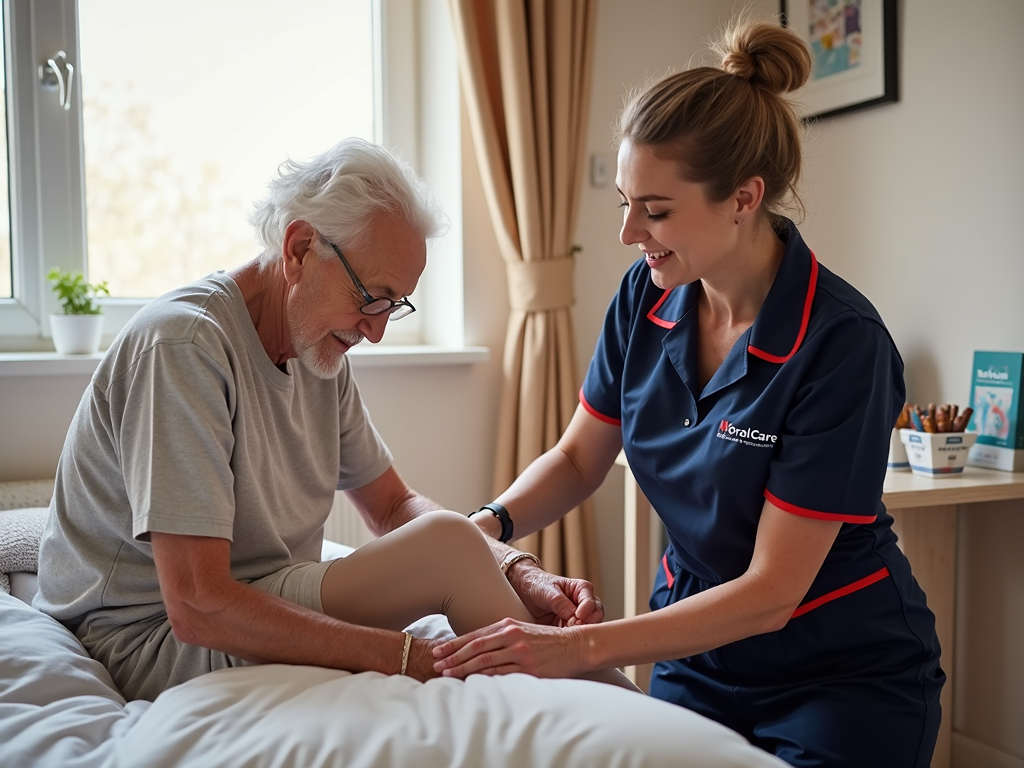Compression Stockings: Correct Use, Purpose, and Benefits for Better Circulation

Compression stockings are a vital medical device that can significantly improve circulation, prevent serious complications, and enhance quality of life for many people. Despite their importance, they're often misunderstood or used incorrectly, which can reduce their effectiveness or even cause harm. This comprehensive guide explains everything you need to know about compression stockings, from their medical purpose to proper application and care.
Understanding Compression Stockings
What Are Compression Stockings?
Definition and Design: Compression stockings are specially designed hosiery that applies graduated pressure to the legs and feet. They're made from elastic materials that provide controlled compression, with the highest pressure at the ankle that gradually decreases up the leg. This graduated compression helps improve blood flow back to the heart.
How They Work:
Graduated pressure: Strongest at ankle (100%), decreasing up the leg
Venous return: Help push blood back towards the heart
Valve support: Assist one-way valves in leg veins
Muscle pump enhancement: Support the natural muscle pump action
Swelling reduction: Prevent fluid accumulation in tissues
Types of Compression:
Anti-embolism stockings: For bedridden patients
Graduated compression stockings: For active individuals
Medical compression hosiery: Prescribed for specific conditions
Support hosiery: Lower compression for general comfort
Medical Purpose and Benefits
Primary Medical Functions:
Improve circulation: Enhance blood flow from legs back to heart
Prevent blood clots: Reduce risk of deep vein thrombosis (DVT)
Reduce swelling: Prevent and treat oedema
Support veins: Help damaged or weak vein valves function better
Symptom relief: Alleviate pain, heaviness, and fatigue in legs
Specific Health Benefits:
Venous insufficiency: Support for damaged vein valves
Varicose veins: Reduce symptoms and prevent progression
Post-surgical recovery: Prevent complications after operations
Pregnancy support: Manage increased blood volume effects
Occupational health: Support for prolonged standing or sitting
Who Needs Compression Stockings?
Medical Conditions
Venous Disorders:
Chronic venous insufficiency: When vein valves don't work properly
Varicose veins: Enlarged, twisted veins
Spider veins: Small, damaged veins near skin surface
Post-thrombotic syndrome: After previous blood clots
Venous ulcers: Wounds caused by poor circulation
Blood Clot Prevention:
Deep vein thrombosis (DVT) history: Previous blood clots
Pulmonary embolism risk: High risk of clots travelling to lungs
Post-surgical patients: Especially orthopaedic and abdominal surgery
Immobility periods: Bed rest or limited movement
Long-distance travel: Flights over 4 hours
Other Medical Indications:
Lymphoedema: Swelling from lymphatic system problems
Diabetes complications: Poor circulation in legs
Heart failure: Fluid retention and circulation issues
Pregnancy complications: Severe swelling or circulation problems
Occupational requirements: Healthcare workers, pilots
Risk Factors
Age-Related Factors:
Over 60 years: Increased risk of circulation problems
Reduced mobility: Less active lifestyle
Multiple medications: Some drugs affect circulation
Chronic conditions: Diabetes, heart disease, arthritis
Previous injuries: Leg fractures or surgeries
Lifestyle Factors:
Prolonged standing: Teachers, retail workers, healthcare staff
Prolonged sitting: Office workers, drivers, frequent flyers
Obesity: Extra weight affecting circulation
Smoking: Damages blood vessels
Sedentary lifestyle: Lack of regular exercise
Types and Compression Levels
Compression Levels Explained
Compression Measurement: Compression is measured in millimetres of mercury (mmHg), the same unit used for blood pressure. The higher the number, the stronger the compression.
Level 1: Light Compression (8-15 mmHg):
Purpose: General comfort and mild support
Users: Healthy individuals with tired, aching legs
Activities: Long periods of standing or sitting
Availability: Over-the-counter purchase
Benefits: Prevents minor swelling, improves comfort
Level 2: Moderate Compression (15-20 mmHg):
Purpose: Prevention and mild treatment
Users: Early varicose veins, minor swelling
Activities: Travel, pregnancy, occupational use
Availability: Over-the-counter or prescribed
Benefits: Prevents progression of minor vein problems
Level 3: Firm Compression (20-30 mmHg):
Purpose: Treatment of established conditions
Users: Moderate varicose veins, post-surgical recovery
Conditions: DVT prevention, chronic venous insufficiency
Availability: Usually requires prescription
Benefits: Significant symptom improvement
Level 4: Extra Firm Compression (30-40 mmHg):
Purpose: Severe venous conditions
Users: Severe varicose veins, post-thrombotic syndrome
Conditions: Chronic venous insufficiency, lymphoedema
Availability: Prescription required
Benefits: Maximum therapeutic effect
Level 5: Maximum Compression (40-50 mmHg+):
Purpose: Severe lymphoedema and venous disorders
Users: Complex medical conditions
Supervision: Specialist medical oversight required
Availability: Specialist prescription only
Benefits: Treatment of severe, chronic conditions
Styles and Lengths
Knee-High Stockings:
Coverage: Foot to just below knee
Uses: Most common type for general circulation
Benefits: Easy to put on, suitable for most conditions
Ideal for: Varicose veins, mild swelling, prevention
Considerations: May roll down if not properly fitted
Thigh-High Stockings:
Coverage: Foot to upper thigh
Uses: More extensive venous problems
Benefits: Better coverage for thigh veins
Ideal for: Extensive varicose veins, post-surgical use
Considerations: May be difficult to keep in place
Pantyhose Style:
Coverage: Full leg and waist coverage
Uses: Pregnancy, extensive venous disease
Benefits: Stay in place well, comprehensive coverage
Ideal for: Pregnancy, bilateral leg problems
Considerations: More difficult to put on
Open-Toe vs Closed-Toe:
Open-toe: Better for foot problems, easier fitting
Closed-toe: Complete coverage, better appearance
Choice factors: Foot health, shoe fitting, personal preference
Medical considerations: Toe circulation, wound care needs
Proper Application Techniques
Before Putting On Stockings
Preparation Steps:
Morning application: Put on first thing after waking
Clean, dry legs: Wash and thoroughly dry legs and feet
Moisturise carefully: Use non-greasy lotion, allow to absorb
Check for problems: Inspect legs for cuts, sores, or irritation
Gather supplies: Stockings, gloves (if needed), application aids
Timing Considerations:
Best time: Early morning when legs are least swollen
Avoid: After standing, walking, or bathing when legs may be swollen
Consistency: Same time each day for routine
Pre-activity: Before getting out of bed if possible
Medical advice: Follow specific timing instructions from healthcare provider
Step-by-Step Application
Traditional Method:
Turn stocking inside out to the heel
Place foot into toe section ensuring proper heel placement
Gradually roll stocking up leg, smoothing as you go
Avoid pulling from top which can damage the stocking
Check for wrinkles and smooth out any bunching
Ensure proper positioning at knee or thigh level
Detailed Application Process:
Sit on edge of bed or stable chair
Insert hand into stocking and grasp heel section
Turn stocking inside out until you reach the heel
Slip foot into stocking ensuring toes are properly positioned
Check heel placement - heel of stocking should match your heel
Gradually unroll stocking up the leg using both hands
Smooth out wrinkles as you progress up the leg
Avoid overstretching the material
Common Mistakes to Avoid:
Pulling from the top can tear the stocking
Rushing the process leads to improper fit
Ignoring wrinkles can cause pressure points
Wrong size selection affects effectiveness
Putting on over swollen legs reduces effectiveness
Application Aids and Tools
Stocking Aids:
Sock aids: Metal or plastic frames that hold stocking open
Stocking donners: Devices that help pull stockings up
Rubber gloves: Provide better grip without snagging
Talcum powder: Helps stockings slide on more easily
Silk stocking liners: Make application easier
For Limited Mobility:
Long-handled shoe horns adapted for stockings
Dressing sticks with hooks for pulling up stockings
Elastic shoelaces to avoid bending for shoes
Compression stocking applicators for independence
Professional application by carers when needed
Daily Wear and Care
Wearing Schedule
Daily Routine:
Put on: First thing in the morning
Wear duration: All day until bedtime
Remove: Before going to bed at night
Consistency: Every day as prescribed
Activity levels: Wear during all daily activities
Special Circumstances:
Exercise: Usually safe to wear during moderate exercise
Swimming: Remove before swimming, reapply after
Sleeping: Generally not worn overnight unless specifically prescribed
Travel: Especially important during long journeys
Hot weather: May need adjustment for comfort
Monitoring and Adjustment
Daily Checks:
Circulation: Ensure toes remain pink and warm
Comfort: No excessive pain or numbness
Position: Stockings haven't rolled or bunched
Skin condition: No red marks, sores, or irritation
Effectiveness: Legs feel better with stockings on
Warning Signs to Watch:
Numbness or tingling in toes
Blue or purple discolouration of toes
Severe pain or cramping
Red marks that don't fade after removal
Skin breakdown or sores
When to Remove Immediately:
Signs of impaired circulation
Severe discomfort or pain
Skin irritation or breakdown
Swelling above the stocking
Any concerning symptoms
Proper Removal
Evening Removal Process:
Sit comfortably on bed or chair
Roll down gradually from top to bottom
Don't pull or yank which can damage stocking
Turn inside out as you remove
Inspect legs for any marks or irritation
Allow legs to rest overnight without compression
After Removal Care:
Inspect skin for any problems
Moisturise legs with appropriate lotion
Elevate legs if swelling is present
Note any changes in leg condition
Prepare for next day application
Care and Maintenance
Daily Care
After Each Use:
Hand wash in lukewarm water with mild detergent
Rinse thoroughly to remove all soap residue
Gently squeeze water out - don't wring or twist
Lay flat to dry away from direct heat or sunlight
Have spare pairs to wear while others are drying
Washing Instructions:
Water temperature: Lukewarm, never hot
Detergent: Mild, non-biological washing powder
Method: Hand washing preferred, gentle machine cycle acceptable
Fabric softener: Avoid as it can reduce elasticity
Bleach: Never use bleach or harsh chemicals
Storage and Replacement
Proper Storage:
Lay flat in drawer or fold gently
Avoid hanging which can stretch the material
Keep away from sharp objects
Store in cool, dry place
Separate from other hosiery to prevent snagging
When to Replace:
Loss of elasticity: Stockings become loose or baggy
Visible wear: Holes, runs, or thinning material
Reduced effectiveness: Legs feel less supported
Time frame: Typically every 3-6 months with daily use
Professional assessment: Regular review with healthcare provider
Signs of Wear:
Stockings slide down frequently
Material feels loose or stretched
Visible thinning or holes
Reduced compression effectiveness
Discomfort or poor fit
Potential Problems and Solutions
Common Issues
Difficulty Putting On:
Solution: Use application aids or seek help
Prevention: Apply when legs are least swollen
Technique: Take time, don't rush the process
Professional help: Occupational therapist assessment
Alternative options: Different style or compression level
Stockings Rolling Down:
Causes: Wrong size, loss of elasticity, leg shape
Solutions: Proper sizing, replacement, adhesive strips
Prevention: Correct application technique
Professional advice: Fitting assessment
Alternative styles: Different length or style
Skin Irritation:
Causes: Allergic reaction, too tight, poor hygiene
Solutions: Hypoallergenic materials, proper sizing, good skin care
Prevention: Daily skin inspection, appropriate moisturising
Medical attention: If irritation persists
Alternative options: Different materials or brands
Serious Complications
Circulation Problems:
Symptoms: Cold, numb, or discoloured toes
Action: Remove stockings immediately
Medical attention: Contact healthcare provider
Prevention: Proper sizing and regular monitoring
Follow-up: Professional assessment of compression level
Skin Breakdown:
Symptoms: Sores, wounds, or severe irritation
Action: Stop wearing stockings, seek medical advice
Treatment: Wound care and healing before resuming
Prevention: Daily skin inspection and proper hygiene
Professional care: May need specialist wound care
Special Considerations
Diabetes and Compression Stockings
Diabetic Considerations:
Circulation problems: Diabetes affects blood flow
Nerve damage: Reduced sensation in feet
Skin vulnerability: Slower healing, infection risk
Professional supervision: Medical oversight essential
Regular monitoring: Frequent foot and leg checks
Safety Measures:
Daily inspection: Check feet and legs carefully
Proper fitting: Professional measurement is essential
Gradual introduction: Start with lower compression
Medical monitoring: Regular healthcare provider reviews
Emergency awareness: Know when to seek immediate help
Pregnancy and Compression Stockings
Pregnancy Benefits:
Prevent varicose veins during pregnancy
Reduce leg swelling from increased blood volume
Improve comfort during prolonged standing
Support circulation as baby grows
Post-delivery recovery support
Pregnancy Considerations:
Growing belly: May need pantyhose style
Changing leg size: Regular size reassessment
Comfort adjustments: May need different compression levels
Medical supervision: Obstetric approval recommended
Post-delivery: Continued use may be beneficial
Elderly and Mobility Considerations
Age-Related Challenges:
Reduced flexibility: Difficulty bending to apply stockings
Arthritis: Joint pain affecting application
Vision problems: Difficulty seeing the proper placement
Cognitive changes: May forget to wear or remove
Skin fragility: Increased risk of skin damage

Comments